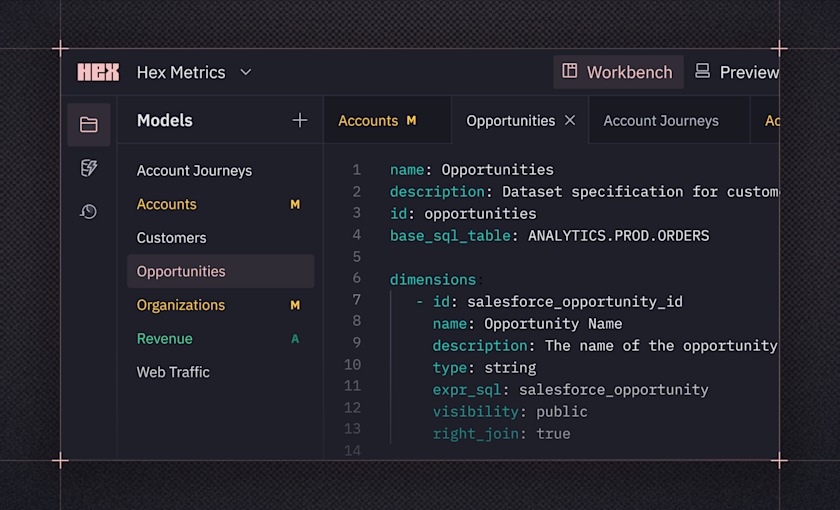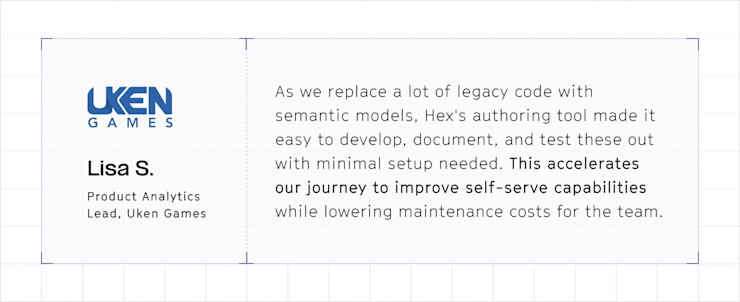
Speed matters! When it takes days or weeks to get an answer back from the data team, stakeholders will go with gut, move on, or just stop asking — and at that point, why even have a data stack?
Over the last few years, Hex has become the tool of choice for over 1,500 data teams to explore data and share insights, in part because it’s flexible and fast, making it so you can get answers quickly, and keep pace with the business.
But when it comes to enabling the rest of the organization to use data, it’s not just speed that counts — you need governance and trust. For less-technical stakeholders, flexibility can be scary — they want things more “on the rails,” and they need confidence they’re going to get the right answers.
At Hex, we’re bringing these two sides of analytics — speed and trust — together in one platform for the first time. Data teams no longer have to choose between these or juggle multiple tools — they can do open exploration, deep-dive analysis, and self-serve all in one place.
Last year, we introduced Semantic Sync and Explore in Hex, enabling teams to turn on trusted self-serve via pre-existing semantic models.
Today, we’re adding a new capability to author semantic models directly in Hex and are calling it (wait for it) Semantic Authoring.
Semantic Authoring is available to Admins as a beta on Team and Enterprise plans.
The golden age of semantic models
Semantic models can be thought of as “instructions for use” for data. Data teams curate and govern definitions of metrics, concepts, and relationships in your business, allowing everyone to build analyses off of them.
This is great… but they have traditionally been a heavy lift to build — lots of upfront work, complex tooling, and unclear ROI. But in the agentic era, that equation is changing.
⬆️ The value of semantic models is growing. They’re no longer just about stakeholder-friendly dashboards or consistent metric definitions. Semantic context is a key ingredient in making AI-generated insights more accurate and aligned with your business logic.
⬇️ The cost of building them is shrinking. AI agents open new possibilities to automating parts of the modeling process, and reducing the manual setup that used to be required.
First-class AI-powered semantic authoring
Now teams can create semantic definitions right where they’re doing their work in Hex. The outputs of this workflow become governed, curated context in the form of semantic models and data apps, which allow for trusted insights by anyone in your organization.

With the new Modeling Workbench, Admins can define measures, dimensions, and joins with autocomplete, inline validation, and help from a Workbench Agent that speeds up modeling with AI. And soon, you’ll be able to create semantic models based on existing work in Hex — no need to re-write or start from scratch.
Before deploying, preview the impact of changes directly in projects to understand the “blast radius” and minimize surprises. Check out the demo below for a full walkthrough of semantic authoring in Hex.
As an alternative to the workbench, you can also build semantic models in Git with your existing CI/CD review process, and sync them into Hex using an API endpoint.
Today, semantic models can be used in Explore cells and referenced by Ask Magic from the homepage and Magic in Explore. Soon, they’ll be available everywhere in Hex, including the ability to query them with SQL.
Our interoperable approach to semantic models
Semantic authoring in Hex is about expanding what’s possible, not replacing what works. That’s why we built Semantic Sync, which makes it easy to sync with standalone semantic layers, so you can leverage your models no matter where they live.
Our vision is a connected, governed source of semantic truth that flows through every part of your data stack — from warehouse, to AI, to notebooks and data apps.
Here’s what that looks like:
Hex reflects and syncs with your semantic models, whether they're defined in dbt metricFlow, Cube, or Snowflake Semantic Views.
Our internal model is designed for portability. Soon, you’ll be able to push semantic definitions authored in Hex out to other systems like Snowflake.
Most BI tools either lock you in or force you to scatter context across disconnected surfaces. We take a different approach — whether your semantic models are authored in Hex or synced from external sources, they’re always available in Hex to query, explore, and use alongside the rest of your work.
Ready to dive in? Check out our Modeling Workbench docs.
A context engine for modern data teams
Hex is a unified platform — notebook, self-serve workspace, and app builder — that brings data teams and business users together in one place, where context compounds. That means faster iteration cycles with tighter feedback loops and fewer silos.
This launch lays the groundwork for context engineering at scale. Semantic models, endorsed data, and AI rules files are just the start of how data teams will curate the context that empowers humans and robots to answer your business’s most challenging questions.